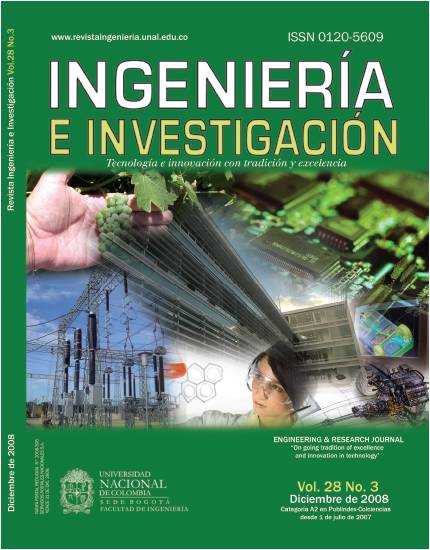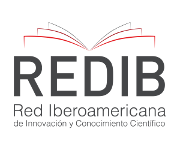Developing a press for static and dynamic testing of orthopedic devices and biological tissue
Desarrollo de una prensa para pruebas estáticas y dinámicas de elementos ortopédicos y tejidos biológicos
DOI:
https://doi.org/10.15446/ing.investig.v28n3.15132Keywords:
mechanical test machine, biomechanical device, external fixer (en)máquina de pruebas mecánicas, dispositivos biomecánicos, fijadores externos (es)
Downloads
This paper describes designing and constructing a test machine having an 1,800 N capacity and maximum 3 Hz frequency which will be used in static and dynamic testing of biological tissues and orthopedic devices such as external fixers. It consists of an octagonal base with 500 mm distance between faces and a crosshead which slides between two columns (useful 350 mm opening) thus allowing changing the height (maximum 600 mm) according to the size of the specimen to be tested. A ball screw actuator is mounted over the crosshead which transforms a servomotor’s rotating movement into a lineal movement (maximum 150 mm stroke). First validations indicated that the machine performed within the design parameters. This project shows that the technology required for supporting research is possible in developing countries thereby avoiding dependence on foreign companies for supporting, maintaining and updating equipment. Some conditions were also produced for the evolution of mechanical engineering in Colombia.
Se describe el diseño y la construcción de una prensa con una capacidad de 1.800 N y una frecuencia máxima de 3 Hz que será utilizada para realizar pruebas estáticas y dinámicas de tejidos biológicos y elementos ortopédicos como fijadores externos. Consta de una base octagonal con una distancia entre caras de 500 mm y un travesaño que desliza sobre dos columnas (distancia útil de 350 mm), permitiendo así modificar la altura de trabajo (máxima de 600 mm) de acuerdo con el tamaño del elemento a probar. Sobre el travesaño está montado un actuador de tornillo con tuerca de bolas recirculantes, el cual transforma la rotación de un servomotor en un desplazamiento lineal (máximo de 150 mm). Las primeras validaciones indicaron un comportamiento de la prensa dentro de los parámetros de diseño estipulados. Este proyecto tiende a demostrar que en países en desarrollo es posible generar la tecnología necesaria para apoyar la investigación, lo que evita crear una dependencia de las compañías extranjeras para la modernización, el soporte y el mantenimiento del equipo. Adicionalmente, se generan condiciones para la evolución de la ingeniería mecánica en Colombia.
References
ASTM Committee F04 on Medical and Surgical Materials., Designation F 1541-01, specification and Test Methods for External Esqueletal Fixation Devices, 2001.
Galvis, E., Lasso, P., Machado, A., García, J. J., Computational determination of the 3-D stiffness matrix of an Ilizarov fixator., Advances in Bioengineering, ASME, BED-Vol. 51, 2001. DOI: https://doi.org/10.1115/IMECE2001/BED-23077
Gardner, T. N., Simpson, H., Kenwrigth, J., Rapid Application fracture fixation - an evaluation of mechanical performance., Clinical Biomechanics, Vol. 16, No. 2, February, 2001, pp. 151- 159. DOI: https://doi.org/10.1016/S0268-0033(00)00071-1
García, J. J., Cortés, D. H., A nonlinear biphasic viscohyperelastic model for articular cartilage., Journal of Biomechanics, Vol. 39, 2006, pp. 2991–2998. DOI: https://doi.org/10.1016/j.jbiomech.2005.10.017
Leyton, A., García J. J., Machado, A., Echeverry, A. A., Caracterización Mecánica del Fijador Externo “Atlas” para Fracturas de Huesos., Ingeniería y Competitividad, Vol. 5, No 1, octubre, 2003, pp. 7-15 DOI: https://doi.org/10.25100/iyc.v5i1.2300
Smitth, C. D., Masouros, S., Hill, A. M., Wallace, A. L., Amis, A. A., Bull, A. M. J., Mechanical testing of intra-articular tissues. Relation experiments to physiological function., Current Orthopedics, Vol. 22, 2008, pp. 341-348. DOI: https://doi.org/10.1016/j.cuor.2008.07.010
Wilson, W., Van Donkellar, C. C., Van Rietbergen, B., Huiskes, R., A fibril-reinforced poroviscoelastic swelling model for articular cartilage., Journal of Biomechanics, Vol. 38, 2005, pp. 1195– 1204. DOI: https://doi.org/10.1016/j.jbiomech.2004.07.003
Wilson, W., An Explanation for the Onset of Mechanically Induced Cartilage Damage., Eindhoven: Technische Universiteit Eindhoven, 2005.
Yang, L., Nagayam, S., Saleh, M., Stiffness characteristics and interfragmentary displacements with different hybrid external fixators., Clinical Biomechanics, Vol. 18, No. 2, January, 2003, pp. 166-172. DOI: https://doi.org/10.1016/S0268-0033(02)00175-4
How to Cite
APA
ACM
ACS
ABNT
Chicago
Harvard
IEEE
MLA
Turabian
Vancouver
Download Citation
CrossRef Cited-by
1. Richard Moran, Khosrow Ghavami, José J. García. (2017). A new method to measure the axial and shear moduli of bamboo. Proceedings of the Institution of Civil Engineers - Structures and Buildings, 170(4), p.303. https://doi.org/10.1680/jstbu.16.00045.
2. Gustavo Orozco, Laura Villegas, José Jaime García. (2014). Mechanical Behavior of Bamboo Species Guadua angustifolia under Compression along the Thickness of the Culm. Key Engineering Materials, 600, p.49. https://doi.org/10.4028/www.scientific.net/KEM.600.49.
Dimensions
PlumX
Article abstract page views
Downloads
License
Copyright (c) 2008 Arlex Leyton Virgen, José Daniel Ballén Briceño, Richard Moran Perafán, Fernando Casanova García, Carlos Rafael Pinedo Jaramillo, José Jaime García Alvarez

This work is licensed under a Creative Commons Attribution 4.0 International License.
The authors or holders of the copyright for each article hereby confer exclusive, limited and free authorization on the Universidad Nacional de Colombia's journal Ingeniería e Investigación concerning the aforementioned article which, once it has been evaluated and approved, will be submitted for publication, in line with the following items:
1. The version which has been corrected according to the evaluators' suggestions will be remitted and it will be made clear whether the aforementioned article is an unedited document regarding which the rights to be authorized are held and total responsibility will be assumed by the authors for the content of the work being submitted to Ingeniería e Investigación, the Universidad Nacional de Colombia and third-parties;
2. The authorization conferred on the journal will come into force from the date on which it is included in the respective volume and issue of Ingeniería e Investigación in the Open Journal Systems and on the journal's main page (https://revistas.unal.edu.co/index.php/ingeinv), as well as in different databases and indices in which the publication is indexed;
3. The authors authorize the Universidad Nacional de Colombia's journal Ingeniería e Investigación to publish the document in whatever required format (printed, digital, electronic or whatsoever known or yet to be discovered form) and authorize Ingeniería e Investigación to include the work in any indices and/or search engines deemed necessary for promoting its diffusion;
4. The authors accept that such authorization is given free of charge and they, therefore, waive any right to receive remuneration from the publication, distribution, public communication and any use whatsoever referred to in the terms of this authorization.



























